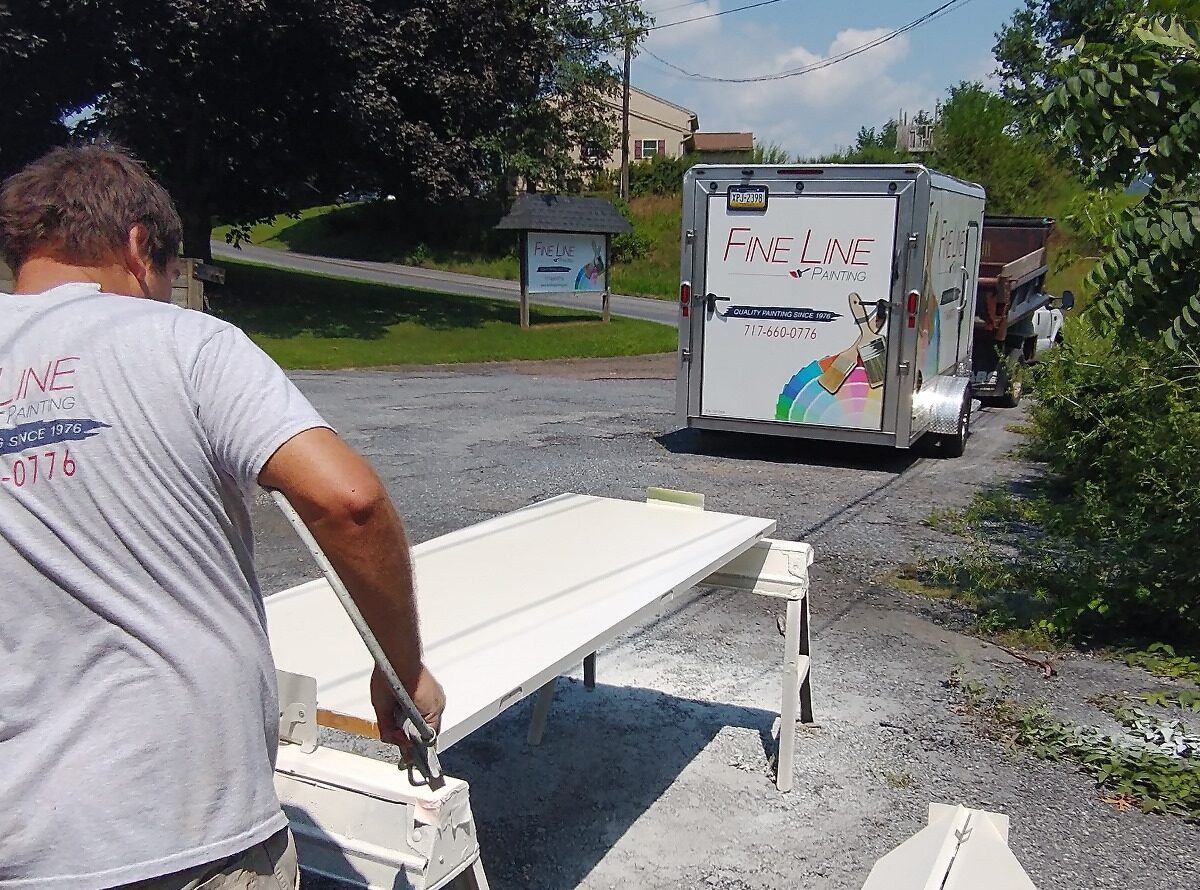Are you nearing the end of a whole home painting project and aren’t sure how you aren’t sure how you are going to paint the doors? Or are your doors starting to appear dingy and worn out with all life’s wear and tear? If you’re looking for the best way to paint your doors, this is the article for you! We’ll explain the difference between rolling and spraying, the benefits of spraying doors, and answer commonly asked questions when it comes to door spraying. You’ll learn when to hire professional door spraying, average costs and timelines of doing a DIY approach to spraying doors, and more!
Ready to dive into the world of spraying doors? Let’s go!
Rolling vs. Spraying Doors
Before we get too far into this, we have to start with the foundations. What is the difference between rolling and spraying? It’s really quite simple so we won’t spend long on it, but let’s break it down just a bit.
Rolling: The Traditional Method
Rolling is the true classic using a good old paint brush and/or roller and bucket of paint to manually paint your doors. This method is similar to manually painting walls but because of a door’s unique shape and features, it requires a little more precision and patience.
Spraying The Doors: The Modern Solution
In the wonderful modern world of technology, we now have the option to spray our doors. This method uses a paint sprayer to quickly and efficiently apply paint onto a door. This method can cover large areas quickly and is known for its smooth finish. Professionals like Fine Line Painting often use this method when painting doors for a professional, more even approach.
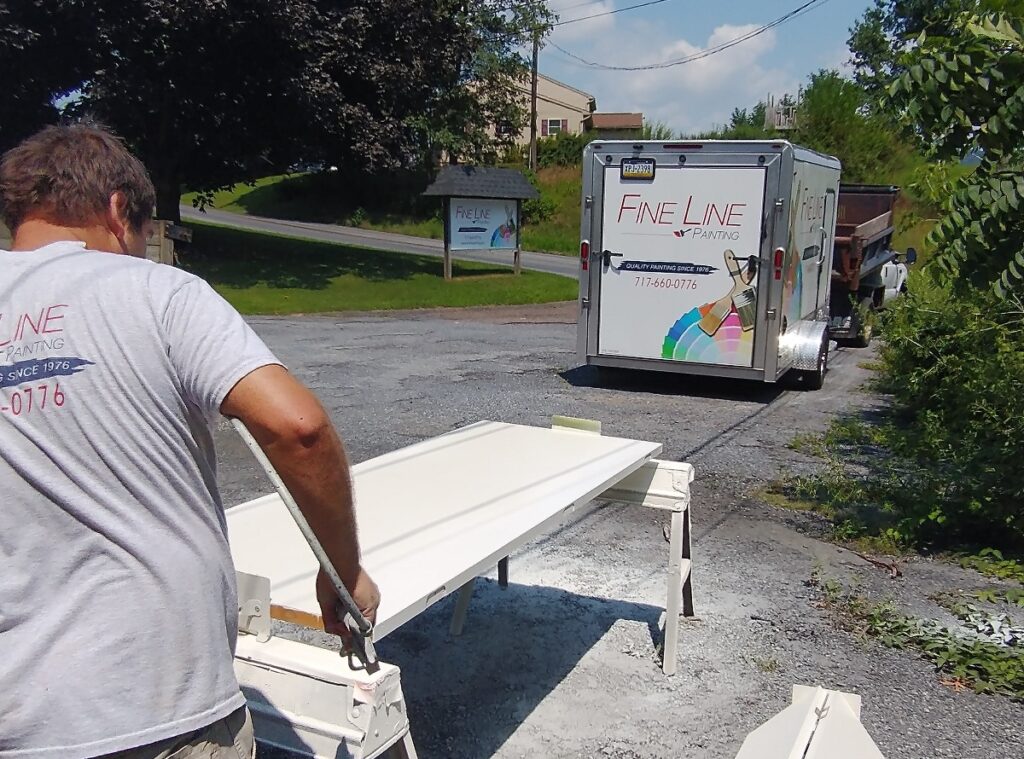
Benefits of Door Spraying
Ok so now you might be wondering why is it important to spray your doors? Why do the professionals care about spraying doors? Read on to find out 5 benefits of spraying your doors.
1. Door Spraying Gives A Professional-looking Finish
One of the most significant benefits of spraying doors is the flawless, smooth finish it provides. Unlike rolling or brushing, which can leave streaks, roller marks, or brush lines, spraying ensures an even coat without any visible texture. This is especially valuable for achieving a high-quality, professional look on your doors. Sprayers create a fine mist of paint, which helps to eliminate those pesky paint marks and lines, resulting in the best look possible.
2. Door Spraying Is Fast
Spraying is incredibly efficient and can cover large surfaces in a fraction of the time it would take to roll or brush. This speed is particularly helpful if you’re working on multiple doors or a large project like painting all the interior doors in your house. You can often apply additional coats more quickly with a sprayer which reduces the total time spent on the project. Sounds amazing to us!
3. Door Spraying Gives Better Paint Adhesion
One of the most frustrating parts of painting doors by hand can be when paint starts to peel, run, or drip. Or maybe the paint is uneven, thicker in one spot than another. Sprayers provide consistent layers of paint, which enhances the adhesion and durability of the finish. For doors with intricate designs, paneling, or moldings, spraying can reach all the nooks and crannies effectively. This ensures that every part of the door is evenly coated, including hard-to-reach areas that might be challenging with a roller or brush.
4.Door Spraying Is Easier
While it’s great to work hard, sometimes the hours spent using a paint brush to paint all the doors in your house can be both exhausting and physically taxing on your body. Using a sprayer is much less physically demanding than rolling or brushing, especially when dealing with large or multiple doors. The sprayer does much of the work for you, reducing the strain on your arms and back.
5. Door Spraying Is Less Messy
Nobody wants to spend hours cleaning up stubborn paint splatters from the beautiful hardwood floors. Modern paint sprayers are designed to minimize overspray, reducing the mess and potential for paint to get on surrounding surfaces. With proper masking and preparation, you can achieve a clean application with less cleanup required afterward. While paint sprayers do require thorough cleaning after use, many models are designed to be disassembled and cleaned efficiently. This can be easier and quicker than cleaning multiple brushes and rollers, especially if you’re working with several colors or finishes on your doors.
We hope you’re convinced now about the benefits of spraying your doors and you’re going to choose professionals that spray their doors. Luckily for you, here at Fine Line Painting, we always spray our doors for the best, most professional look possible! Get your free quote today!
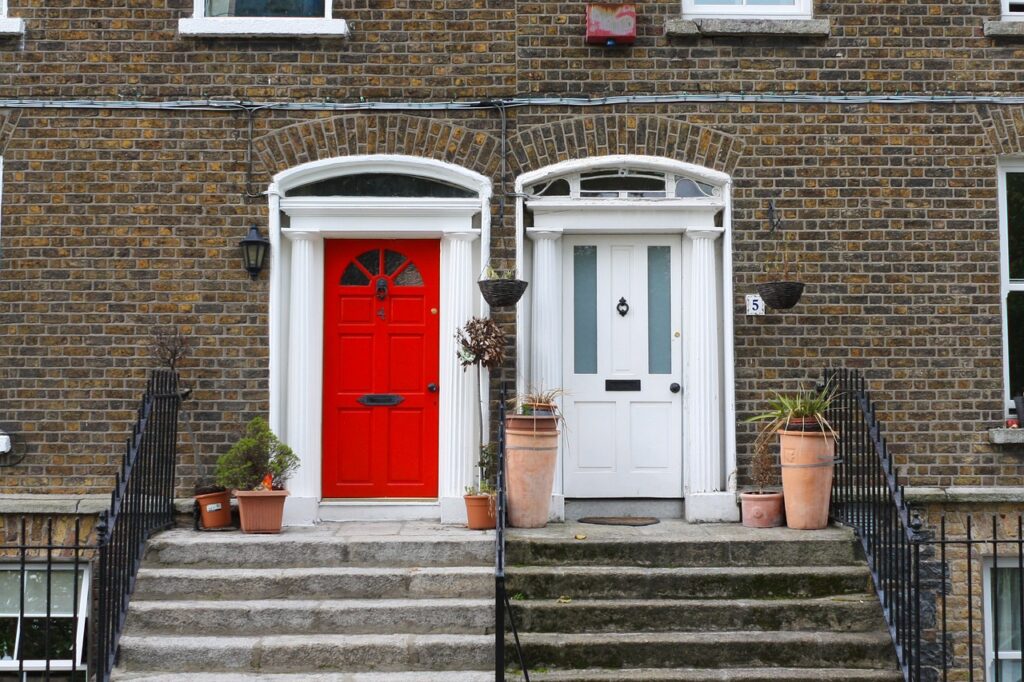
Commonly Asked Questions About Door Spraying
Ready to dive into answering some of the common questions regarding spraying doors? From how to paint your door, to what paint you can use, and when to call the professionals, we got you covered!
How Do You Do A DIY Door Spraying Job?
Everyone has their own process when it comes to painting. Some people prefer the quickest, most efficient way even if it means compromising on some details. Others take as long as is needed to ensure the most detailed and high-quality job possible. While there are different ways to paint an interior door, here is a 5 step process that we recommend.
Step 1: Preparation
While you can paint a door while it’s still hanging, removing it will make the job easier and prevent any paint from accidentally getting on the hinges or surrounding areas. If you choose to remove the door, place it on a pair of sawhorses or a flat surface covered with a drop cloth.
Take off all hardware, including knobs, locks, and hinges and thoroughly clean the door to remove any dust, grease, or dirt. Use a mild soap solution and a sponge, then dry completely. Once clean, lightly sand the door using fine-grit sandpaper to create a smooth surface. Inspect the door for any dents, scratches, or holes. Use a wood filler or spackle to fill these imperfections, then sand the areas smooth once dry. Lay down a drop cloth or painter’s tape around the door frame and any adjacent walls or floors to protect from spills. After the door has been prepared, make sure your work area is set up, your sprayer has been filled with paint, and you are ready to go!
Step 2: Priming
Select a primer that matches your paint type. For most interior doors, a high-quality latex or acrylic primer works well. If the door is made of a material that tends to bleed through (like mahogany), consider a shellac-based primer. Using a high-quality paint sprayer, apply the primer in thin even coats, or use a brush and roller to manually apply the paint. Allow the primer to dry completely. If you want an ultra-smooth finish, you can lightly sand the primed door with fine-grit sandpaper (320-grit) before applying the first coat of paint.
Step 3: Painting
Now you’re ready for the good part! Select your latex-based paint and finish. Satin or semi-gloss are usually popular choices for doors because they are both durable and easy to clean. Slowly apply the paint in thin, even coats to avoid drips and ensure a smooth finish. Allow the paint to dry completely in between different coats. Typically, we recommend two to three coats for an even coverage.
Step 4: Reassemble and Touch Up
Once the final coat of paint is completely dry, reattach the hardware, including knobs, locks, and hinges. If you removed the door, hang it back on its frame. Inspect the door for any areas that might need touch-ups and if needed, you can use a small brush to carefully fix any spots or imperfections. Remove painter’s tape and drop cloths and clean up your work area. Also, you will need to clean your sprayer according to the manufacturer’s instructions.
Step 5: Curing and Maintenance
Even though the door might feel dry to the touch, it’s important to let it fully cure. Avoid using the door or placing any items against it until it’s completely cured. We suggest a few days, but follow your specific paint’s guidelines for specific curing times.To keep your painted door looking fresh, clean it regularly with a damp cloth and avoid abrasive cleaners that could damage the paint. Touch up any scuffs or scratches as needed to maintain the door’s appearance. And that’s it! You’re finished with spray painting your interior doors!
How To Get a Smooth Paint Finish on an Interior Door?
One of the biggest tricks to a smooth finish when spray painting doors is to put the paint on thin. Unlike using a fine brush or roller, spray thoroughly cleaning your doors, ridding them of all dirt and debris, and sanding them if needed. If you are painting over old paint, you might need to sand small sections to remove rough patches. If the doors are bad enough, you will probably need to strip the whole thing. While it seems like an additional headache, properly preparing your surface will make a huge difference! If you don’t feel like dealing with the hassle, let an expert team take care of it for you!
How To Spray Paint a Cabinet Door?
Maybe you’re just renovating your kitchen and you’re not worried about the big doors, but it’s all the little cabinet doors you’re wondering if you can spray paint cabinet doors. The answer is yes! Following the processes detailed above will yield you a professional look. Even though cabinet doors are obviously smaller than most interior doors, you can still use a paint sprayer for that smooth finish. Simply make sure you are cleaning your doors, removing them from the hinges (or taping off the hinges) and applying the paint in thin even coats. It is more likely that you will need to sand down cabinet doors and spend more time cleaning them because of their high visibility and usage.
Is There a Difference Between Spraying Interior and Exterior Doors?
While much of the focus of this article has been on interior doors, what if you are working on exterior doors? Here are a few key differences between interior and exterior doors that can help you think about the important things in your next paint project. First, you will apply a thin fine layer of paint onto the door. Starting at the top, work your way down slowly, using slow even sprays for the smoothest look possible. Let that coat dry, then apply 1-2 more coats. Additionally, as mentioned earlier, surface preparation is key!
| Type of Door | Environment | Priming | Paint | Drying Time |
| Interior Doors | Controlled/protected environment | Not as high priority although still important. | Often chosen more for the aesthetic, usually latex based paints. Often a high gloss or matte finish | A much faster drying time if proper ventilation is used. |
| Exterior Doors | Exposed to the elements | High priority to protect against moisture | Focused on durability and protection,using exterior grade paint. Often with a semi-gloss or gloss finish. | Needs a longer time to thoroughly cure before using. |
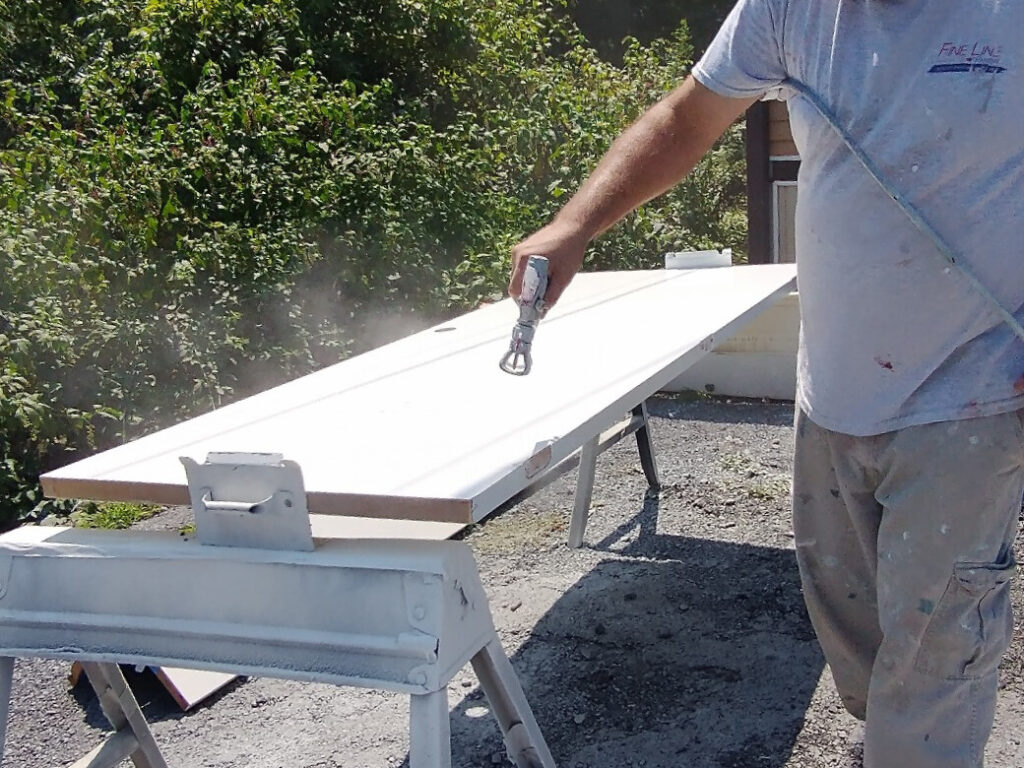
What Paint Should I Use for a Paint Sprayer?
When it comes to painting, you want to use the best paint possible to avoid a redo job or a poor finish. At Fine Line Painting, we use Sherwin Williams high quality interior trim paint for a professional, smooth look. A high-quality latex-based paint is ideal for both interior and exterior doors.
How Much Does It Cost to Spray Paint Interior Doors?
What a loaded question! Cost factors can get tricky, especially if you are trying to DIY it or hire a professional. However, going off of national averages, it could cost you between $50-200 per door (labor costs included). A gallon of paint can cost anywhere from $10-80 which will significantly impact how much it will cost if you do it yourself. When doing it yourself, you will need to factor in the costs of: your time, your tools, and paint. Adding up all of these things can give you a more realistic picture of how much it will cost. If you hire a professional, get a free quote from them to find out what they offer!
How Long Does It Take To Spray Paint Interior Doors?
The short answer to this question is: it depends. If you are already armed with some painting experience, especially with a spray painter, it will speed up the process. If you are new to the whole thing, it could take a little longer. Typically, to spray paint one side of a door with one coat takes 2-4 minutes compared to 10-15 with a brush or roller. So if you are giving two coats to both sides of your doors, it will probably take you anywhere from 8-12 minutes per door. Pretty fast right?
Note: these time estimates do not include the time to remove the doors from hinges, cleaning and prepping them, and putting paint in the sprayer. This is strictly for time spent spraying the doors.
Do Professional Painters Use a Paint Sprayer?
Yes! Because of the ease of coverage and smooth finish, many professional painting companies use a paint sprayer to complete their door painting projects. Of course, there are times when a roller is used, but many professionals prefer to use a sprayer for doors for the smoothest look possible.
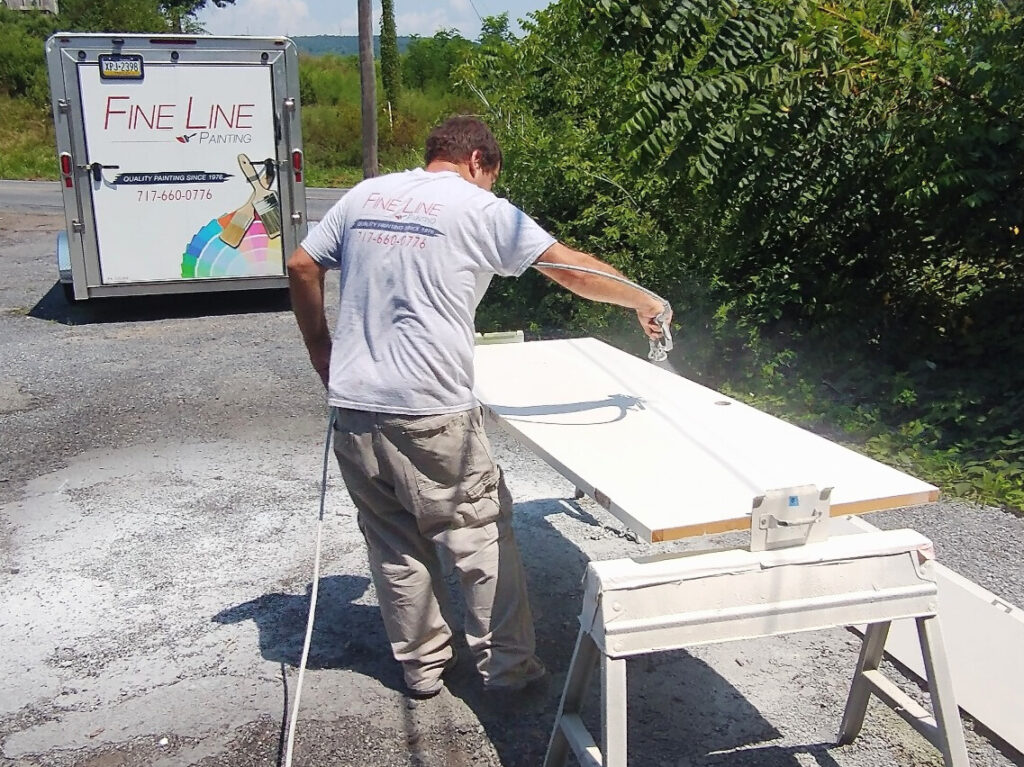
When Should I Hire A Professional to Spray Paint My Doors?
It’s always easy to think that we can save ourselves lots of money by doing a paint job by ourselves? While there are certainly times when it is great to DIY certain home projects, other times we need to call in the professionals. Here are 5 instances when you should hire a professional door spraying service.
- Lack of time
This one might feel obvious, but it still rings true. Sometimes we simply don’t have the time to do the project ourselves. If you’re feeling overwhelmed about spray painting your doors yourself, let an expert team handle it! They’ll do a great job and save you hours of time in the process!
- Intricate details
Some homes have doors with intricate details on the paneling and frames. All of those little details are going to make it more difficult for you to achieve that high-quality smooth finish when painting your interior doors. This is a great time to let a professional painting company take care of the details for you!
- Insufficient expertise
Spray painting doors requires some home renovation skills and a certain level of precision and attention to detail. It’s totally acceptable if you don’t feel qualified to take up the challenge! There is no shame in allowing an expert team with years of experience take the lead on this one.
- Missing materials
To spray paint your doors, you will need to purchase or acquire a paint sprayer from somewhere. In addition you will need paint (pretty obvious we know but it’s still true), masks to protect against any fumes, drop cloths, painters tape, and other basic painting tools. If you don’t have these materials readily available, you will most likely not save yourself much money by buying everything yourself versus paying an expert company with all the tools to do the job.
- Large-scale projects
A touch up on a door or two is not that big of a deal. But if we’re talking all the doors in a brand new home? That’s a different story. Painting can take a very long time so if you have a big painting project, let skilled professionals help you out!
Wrapping Up…
By now, we hope you understand the ins and outs of spraying doors and feel prepared to handle your next project, whether you go the DIY route or choose a skilled professional door spraying company. If you live in the central PA area, we are excited to offer you our detailed, professional services here at Fine Line Painting! From our large scale exterior projects to the little interior details, we have you covered! Simply fill out a free quote form or contact us to learn more!
